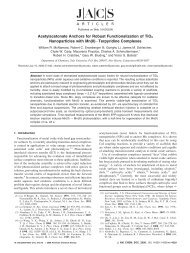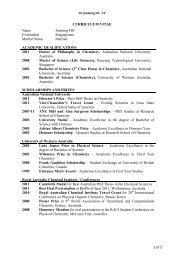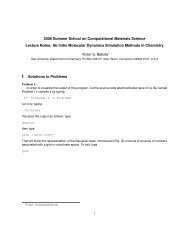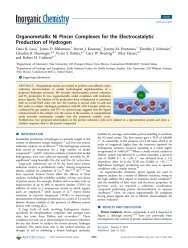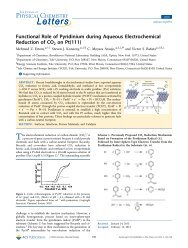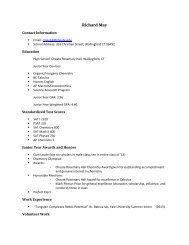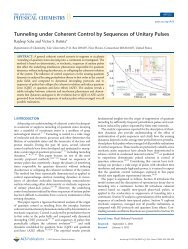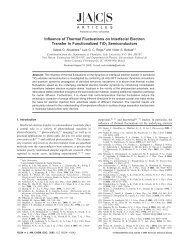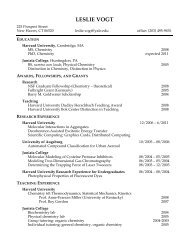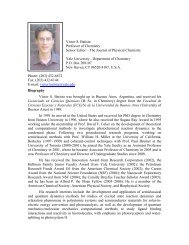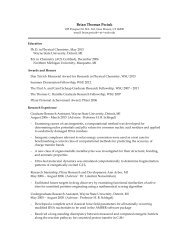Kepler PredictorâCorrector Algorithm - Yale Chemistry - Yale ...
Kepler PredictorâCorrector Algorithm - Yale Chemistry - Yale ...
Kepler PredictorâCorrector Algorithm - Yale Chemistry - Yale ...
You also want an ePaper? Increase the reach of your titles
YUMPU automatically turns print PDFs into web optimized ePapers that Google loves.
Journal of Chemical Theory and Computation<br />
ARTICLE<br />
Figure 3. Initial (left) and final (right) densities for impact parameter 0.4 Å for electron scattering in models I (top) and II (bottom), respectively. Large<br />
dots indicate proton positions; small dots are WCD representative configurations. Contours are drawn at percentages of the maximum density<br />
(integrated over the z coordinate) found at σ,2 σ, and 3 σ from the center of the distribution, i.e., 60.65%, 13.5%, and 1.1%. Color key: SOFT (red),<br />
WCD (blue).<br />
well. As a result, the position predicted by the Wigner transform<br />
lags behind the quantum result, faintly visible in Figure 2.<br />
The convex features of the final quantum densities are<br />
reproduced well by the WCD method, while concave features<br />
in the lowest contour level of the quantum density are due to<br />
interference effects and by construction not present in WCD.<br />
Nevertheless, the semiclassical Wigner transform reproduces the<br />
overall features of the quantum distribution. In fact, a quantitative<br />
analysis of the normalized distributions shows >92% overlap<br />
between the semiclassical and quantum distributions for all cases<br />
investigated. Even the time-dependent widths, describing the<br />
anisotropy of the distribution functions, are in good qualitative<br />
agreement with full quantum results.<br />
Figure 4 shows the widths for each of the Cartesian directions<br />
describing the time-dependent anisotropy of the distributions.<br />
Note that both quantum and semiclassical results show more<br />
delocalization along the x direction than in the orthogonal<br />
directions y and z. This is likely due to the head-on collision<br />
causing the wave packet to undergo more significant deformation<br />
in the direction of propagation.<br />
Figure 4 shows that the semiclassical distributions slightly<br />
overestimate the widths since they miss interference effects<br />
leading to partial localization of the quantum wave packet. This<br />
is most prominent in the x direction due to the bound component<br />
of the semiclassical distributions, although the trends and<br />
overall agreement are quite satisfactory. In fact, close inspection<br />
of Figure 3 shows that the semiclassical dynamics reproduce the<br />
full-quantum distributions very well, while featuring bound<br />
components and deviations at the lowest-density contour level.<br />
The concave features in the final quantum density are due to<br />
interference effects, which by construction are not present in<br />
WCD. At electron energies above 1 keV, interference becomes<br />
negligible, and the agreement of WCD with quantum results<br />
becomes excellent. Deviations in the long tails of the distributions,<br />
however, affect the overall widths σ disproportionately.<br />
Analogous results are obtained for the description of electron<br />
scattering through a cluster of protons (model III). Figure 5<br />
shows the semiclassical (blue) and quantum (red) distributions<br />
for a high-energy collision of an electron passing through a<br />
disordered cluster of 125 protons (black dots, shown larger for<br />
protons closer to the z = 0 plane), at the initial (left, t = 0 as) and<br />
final (right, t = 50 as) propagation times. The configuration of<br />
the cluster, 43 contained in a box with dimensions 5 5 5 Å, has<br />
been extracted from a plasma of density F =10 24 cm 3 . The<br />
initial state for the scattering electron is defined with a width<br />
according to a 1s state of a hydrogen atom, and with initial kinetic<br />
energy p 0 2 /2m e = 250 eV.<br />
Numerical Effort. Wall times for production run calculations<br />
on a 2.67 GHz intel Core i7 CPU are shown in Table 2. KPC<br />
calculations (second column) are compared to results obtained<br />
according to the adaptive velocity Verlet method (third column)<br />
for two sets of trajectories. The total simulation time is 50 as (5 <br />
10 17 s). A maximum of 2 20 subdivisions of the default time step<br />
was allowed, after which a trajectory was marked as failed if it did<br />
not satisfy a maximum allowed energy change of 2.72 10 2<br />
eV/fs in one default time step. Trajectories do not fail for the<br />
KPC method, while a complete treatment of the failed trajectories<br />
in the velocity Verlet method require longer times than<br />
given here or are impossible altogether. A larger number of<br />
trajectories with randomized initial conditions means an increase<br />
31 dx.doi.org/10.1021/ct200452h |J. Chem. Theory Comput. 2012, 8, 24–35



